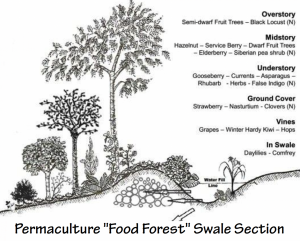Principles of Permaculture
Food Forest Definition
A Permaculture food forest is a layered forest style garden with a diverse planting of edible plant species that attempts to mimic the ecosystems and patterns found in nature. Food forests are three dimensional designs, with life extending in all directions – up, down, and out. They are often integrated with Permaculture swales and berms as shown in the drawing below. Soil life growth can be accelerated in newly installed berms by adding plant debris or old logs as shown, with the popular hugelkultur technique perfected by Sepp Holzer in Austria and also promoted by Geoff Lawton at the international Permaculture Institute of Australia.

A food forest garden generally has the following eight layers:
- Overstory
- Midstory
- Understory
- Herbaceous layer
- Ground Cover
- Vines
- Root layer
- Mycelial network layer (example, mushrooms)
By intentionally including strategic combinations of compatible species in all of these layers, one can fit many more productive plants in a farm growing area with helpful synergistic benefits, in a manner that avoids competition that can cause production decline or system failure.









